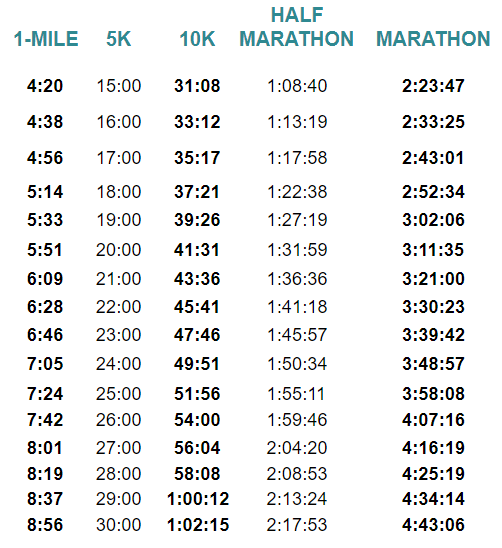Running a marathon is one of the most challenging yet rewarding physical feats you can undertake. Among marathon runners, the 4-hour marathon is a legendary milestone—a blend of endurance, speed, and strategy that demands dedication and smart training. But is a 4-hour marathon realistic for you?
Understanding the 4-Hour Marathon Goal
Running a marathon in under four hours isn’t just about putting one foot in front of the other; it’s about consistency, preparation, and a dash of mental fortitude.
What Is a 4-Hour Marathon Pace?
To run a marathon in 4 hours, your average pace needs to be 9 minutes and 9 seconds per mile (or roughly 5 minutes and 41 seconds per kilometer). That means maintaining steady splits over 26.2 miles without fading late in the race.
This pace might sound manageable for short distances, but keeping it up for hours is the ultimate test. Here’s a quick look at what this pace looks like in real-world terms:
| Distance | Time Needed at 4-Hour Pace |
|---|---|
| 5K | 28:28 |
| 10K | 56:57 |
| Half Marathon | 2:04:30 |
| Marathon | 4:00:00 |
The consistency required at this pace is one reason a 4-hour marathon is such a celebrated benchmark.
How Common Is a 4-Hour Marathon?
Here’s some comforting news: you’re not alone in chasing this goal. Many runners aim for a sub-4-hour marathon because it represents a solid blend of speed and endurance. Statistically, about 25%-30% of marathon finishers clock in under 4 hours, making it achievable but far from guaranteed.
To put this into perspective:
- Elite runners finish marathons in just over 2 hours.
- The average marathon finish time worldwide is around 4 hours and 30 minutes for men and 4 hours and 50 minutes for women.
This makes a 4-hour marathon not only realistic but also aspirational, especially for non-elite runners. You’re aiming for better than average, but not quite Olympic-level speed.
Why a 4-Hour Marathon Is a Popular Goal
A 4-hour marathon strikes a balance between achievability and ambition. For many runners, it’s not just about the number but what it represents:
- Symbolic Milestone: Like breaking 10 seconds in the 100-meter sprint or finishing a 5K in under 20 minutes, a sub-4-hour marathon signals mastery over long-distance running.
- Personal Growth: Training for this goal demands commitment and discipline, making it a personal triumph.
- Respected by the Running Community: Whether you’re chatting with casual joggers or serious athletes, a 4-hour marathon is universally recognized as an impressive accomplishment.
Achieving a 4-hour marathon is like earning a badge of honor in the running world—it shows you’re serious, skilled, and ready to tackle more challenges.
Injecting a Bit of Personality
Now, let’s get real. Running for 4 hours straight is no walk in the park (well, unless you’re actually walking in a park). It’s more like negotiating with your legs, lungs, and brain while trying to avoid an all-out mutiny. But hey, isn’t that half the fun? If it were easy, everyone would do it, and marathon medals would be as common as participation ribbons at a kid’s soccer game.
When you think about the numbers and strategy behind a 4-hour marathon, it’s clear that it’s not just realistic—it’s downright exciting to chase. So, are you ready to lace up your shoes and take the first step? Let’s dig deeper into the factors that will help you decide.

Factors That Influence Marathon Performance
Achieving a 4-hour marathon isn’t just about logging miles on the road. Various factors influence whether this goal is realistic for you, ranging from your physical fitness to your lifestyle. Let’s break these down.
Your Running Experience and Base Fitness
Running experience is a major determinant of marathon success. If you’re brand new to running, aiming for a 4-hour marathon right out of the gate may be overly ambitious. Here’s why:
- Beginners: For those just starting out, the focus should be on building a solid foundation of fitness. This involves consistent running, gradually increasing weekly mileage, and developing endurance. Jumping into marathon training without this base can lead to burnout or injury.
- Intermediate Runners: If you’ve already completed a few races, such as a 10K or half marathon, you might be closer to a sub-4-hour goal. Building on your existing fitness and refining your pacing strategy can bridge the gap.
- Advanced Runners: For seasoned runners, the 4-hour marathon is often within reach with targeted training and proper preparation.
💡 Pro Tip: Run a shorter race, like a half marathon, to gauge your fitness. If you can complete a half marathon in under 2 hours, you’re on track to aim for a sub-4-hour marathon.
Age, Gender, and Genetics
While anyone can aim for a 4-hour marathon with determination, certain factors outside your control can influence your performance.
- Age:
- Endurance tends to improve with age, peaking in your late 20s to early 30s. After that, performance may decline slightly, but experience and discipline often compensate.
- Many runners achieve personal bests in their 40s or even 50s, proving that age is just a number (and maybe a few extra stretching sessions).
- Gender:
- Men typically have a slight physiological advantage in speed due to higher muscle mass and VO2 max. However, women often excel in endurance events due to greater efficiency in energy utilization.
- Genetics:
- While you can’t change your DNA, some people are naturally predisposed to excel in endurance sports thanks to a higher VO2 max or favorable muscle composition.
Training Plan and Discipline
Consistency and structure are non-negotiable when training for a 4-hour marathon. The best training plans are tailored to your ability and typically last 16–20 weeks. A solid plan includes:
- Long Runs: The backbone of marathon training, these build the endurance needed to cover 26.2 miles. Most plans include weekly long runs that peak at 18–22 miles.
- Speed Work: Tempo runs, intervals, and hill training improve your lactate threshold and help you maintain pace.
- Rest Days: Overtraining is a common pitfall. Rest days are essential for recovery and injury prevention.
💡 Pro Tip: Use the 80/20 Rule—80% of your runs should be at an easy, conversational pace, while 20% can be focused on speed and intensity.
Nutrition and Recovery
What you put into your body directly affects what you can get out of it on race day. Proper nutrition and recovery routines are vital.
- Diet:
- Focus on a balanced diet rich in carbohydrates (for fuel), proteins (for recovery), and healthy fats.
- During long training runs, experiment with energy gels, sports drinks, or snacks to avoid “hitting the wall.”
- Hydration:
- Dehydration can quickly derail a marathon. Drink plenty of water throughout training, and don’t forget electrolytes to maintain balance.
- Recovery Practices:
- Sleep is your secret weapon for muscle repair and mental resilience.
- Incorporate active recovery, foam rolling, and stretching into your routine.
Balancing Training With Life
We get it—most of us aren’t professional runners with endless hours to train. Finding time for 3–5 weekly runs while juggling work, family, and other responsibilities can feel like its own marathon.
Here are some tips to fit training into a busy schedule:
- Run Early or Late: Make use of time when others are sleeping.
- Combine Training With Commutes: If possible, run to or from work.
- Plan Ahead: Treat your runs like appointments and add them to your calendar.
Remember, every step counts—even if it’s running to catch a bus because you overslept for your morning run. That’s basically speed training, right?
Understanding these factors helps you evaluate whether a 4-hour marathon is realistic and sets the stage for success. While some aspects, like genetics, are beyond your control, many others—like training, nutrition, and discipline—are entirely within your power.

How to Train for a 4-Hour Marathon
Training for a marathon isn’t just about lacing up your shoes and running until your legs give out. It’s a blend of strategy, consistency, and building up endurance while staying injury-free. If a 4-hour marathon is your goal, the right training plan can turn dreams into finish-line realities.
Choosing the Right Training Plan
A structured training plan is your roadmap to success. While there are countless plans available, the best ones share key components tailored to a 4-hour marathon goal.
- Duration: Most marathon training plans are 16–20 weeks long, giving you plenty of time to build endurance and speed.
- Weekly Mileage: Plans typically range from 30 to 50 miles per week, peaking in the later stages.
- Workouts to Expect:
- Long Runs: Done weekly to build endurance.
- Tempo Runs: Help you maintain marathon pace over extended periods.
- Intervals: Short, intense bursts to improve speed and VO2 max.
- Rest Days: Essential for recovery.
💡 Pro Tip: Choose a plan that matches your fitness level. If you’re starting as a beginner, avoid plans that demand high mileage immediately.
Building Endurance
Endurance is the backbone of marathon success. Without it, those 26.2 miles will feel like climbing Everest without oxygen. Here’s how to build it:
- Progressive Long Runs:
- Gradually increase the distance of your weekly long runs, adding about 1 mile per week.
- Include a few runs that are 18–20 miles long to prepare your body for the demands of race day.
- Pacing Your Long Runs:
- Run your long runs at a comfortable pace, about 1–2 minutes slower per mile than your marathon goal pace.
- Avoid the temptation to run too fast; the goal is to build endurance, not burn out.
- Back-to-Back Runs:
- Running on tired legs (e.g., a long run followed by a short recovery run the next day) mimics the fatigue of race day.
Improving Speed and Pacing
To hit a 4-hour marathon, you need to lock in a 9:09 per mile pace and stick to it like glue. Speed work and pacing drills can make this more achievable.
- Tempo Runs:
- Run at a “comfortably hard” pace—just slightly slower than your 10K race pace.
- Example: Start with 20 minutes at tempo pace and gradually increase to 40 minutes.
- Interval Training:
- Alternate between short bursts of fast running and recovery jogs. For example: 6 x 800 meters at a fast pace, with 90 seconds of rest in between.
- This improves your cardiovascular fitness and leg turnover.
- Practice Pacing:
- Use a GPS watch or app to practice running at exactly 9:09 per mile during training runs.
💡 Pro Tip: Don’t just train your legs—train your brain. Visualize yourself maintaining pace, even when the going gets tough.
Cross-Training for a Stronger Body
Running can take a toll on your body, especially during marathon training. Incorporating cross-training helps prevent overuse injuries while building strength and stamina.
- Cycling or Swimming:
- Great low-impact options that improve cardiovascular fitness without stressing your joints.
- Strength Training:
- Focus on exercises that target your core, glutes, and legs. A strong core helps maintain good running form, especially when fatigue sets in.
- Example exercises: Planks, lunges, squats, and deadlifts.
- Yoga or Pilates:
- Improves flexibility, balance, and mental focus—critical for those late-race miles.
Sample Weekly Training Plan for a 4-Hour Marathon
Here’s an example of a balanced training week during the peak of your marathon prep:
| Day | Workout | Details |
|---|---|---|
| Monday | Rest or Cross-Training | Yoga, cycling, or swimming. |
| Tuesday | Tempo Run | 5 miles, including 3 miles at tempo pace. |
| Wednesday | Easy Run | 6 miles at a conversational pace. |
| Thursday | Intervals | 6 x 800 meters fast with recovery jogs. |
| Friday | Rest | Let those legs recover! |
| Saturday | Long Run | 16–18 miles at a slow, steady pace. |
| Sunday | Recovery Run | 3–4 miles, very easy. |
Injecting Some Personality
Training for a marathon is like prepping for a long road trip: you wouldn’t start without a map, snacks, and a solid playlist. Similarly, a training plan gives you structure, energy gels are your snacks, and, well, running podcasts are probably your playlist. Just don’t forget to pack your patience—it’s a marathon, not a sprint, after all.
With a well-structured plan and disciplined execution, you’ll not only feel confident but also capable of reaching that 4-hour mark.

Common Challenges and How to Overcome Them
Even with the best training plan, the road to a 4-hour marathon is rarely smooth. From hitting the wall to juggling training with daily responsibilities, every runner faces challenges. The key is to anticipate these hurdles and have strategies to tackle them head-on.
Hitting the Wall: What It Is and How to Avoid It
The infamous “wall” is every marathoner’s nemesis. It usually strikes around mile 18–20, when your glycogen stores are depleted, leaving you feeling like you’ve hit quicksand. But fear not—this dreaded scenario can often be avoided.
What Causes the Wall?
- Running out of energy due to inadequate carbohydrate intake.
- Poor pacing early in the race, leading to burnout.
- Insufficient endurance training.
How to Avoid It:
- Fuel Smartly During the Race:
- Start fueling early and consistently. Most runners aim for 30–60 grams of carbohydrates per hour, using gels, chews, or sports drinks.
- Practice your race-day nutrition during long runs to find what works for you.
- Pace Yourself:
- Stick to your target pace (9:09 per mile for a 4-hour marathon) and resist the urge to go faster in the early miles.
- Train for the Distance:
- Incorporate long runs of 18–20 miles into your training to prepare your body and mind for those later miles.
💡 Pro Tip: Visualize overcoming the wall during training. Remind yourself that fatigue is temporary and your training has prepared you for this moment.
Injuries During Marathon Training
Training for a marathon puts a significant strain on your body. Unfortunately, injuries can derail your progress if you’re not careful.
Common Injuries and How to Prevent Them:
- Runner’s Knee: Pain around the kneecap caused by overuse.
- Prevention: Strengthen your quads and glutes with exercises like lunges and squats.
- Plantar Fasciitis: Pain in the heel caused by tightness in the foot.
- Prevention: Stretch your calves and roll your feet on a massage ball.
- Shin Splints: Pain along the shinbone from increased mileage.
- Prevention: Gradually increase mileage and avoid running on hard surfaces.
Recovery Tips:
- Listen to Your Body: A slight ache after a long run is normal, but persistent pain is a red flag.
- Take Rest Days Seriously: Recovery is just as important as running. Overtraining is a fast track to injury.
- Cross-Train: Use non-impact activities to stay active while reducing running strain.
Balancing Training With a Busy Life
For most of us, marathon training isn’t a full-time job. Juggling work, family, and social commitments can make sticking to a training plan a challenge.
Time Management Tips for Runners:
- Be Flexible:
- Can’t run in the morning? Shift your run to lunchtime or the evening. The key is consistency, not a perfect schedule.
- Combine Workouts With Errands:
- If possible, run your commute, or plan routes that include errands. (Imagine running to the grocery store and leaving with a banana—you’re basically living the runner’s dream.)
- Plan Ahead:
- Map out your runs for the week in advance. Treat them like any other important appointment.
- Get Support:
- Communicate your goals with family or friends. A supportive cheer squad can make all the difference.
💡 Quick Reality Check: Skipping a run because life gets in the way won’t ruin your training. It’s better to miss a day than overdo it trying to “catch up.”
Staying Motivated When Training Gets Tough
Marathon training can be a grind, especially during the peak weeks when your mileage soars. Motivation dips are normal, but they’re not insurmountable.
Tips for Staying Inspired:
- Remember Your “Why”:
- Whether it’s for fitness, charity, or a personal challenge, keep your motivation front and center.
- Celebrate Small Wins:
- Did you hit a new personal best on your tempo run? Treat yourself (maybe with a new pair of socks—runners know the joy of fresh socks).
- Mix It Up:
- Run new routes, join a group run, or experiment with trail running to keep things interesting.
- Track Your Progress:
- Use a training journal or app to see how far you’ve come. There’s nothing like comparing your first long run to your latest to boost your confidence.
Challenges are inevitable, but they’re also what make marathon training so rewarding. By planning ahead, listening to your body, and staying adaptable, you’ll navigate the obstacles with ease—or at least with fewer blisters.